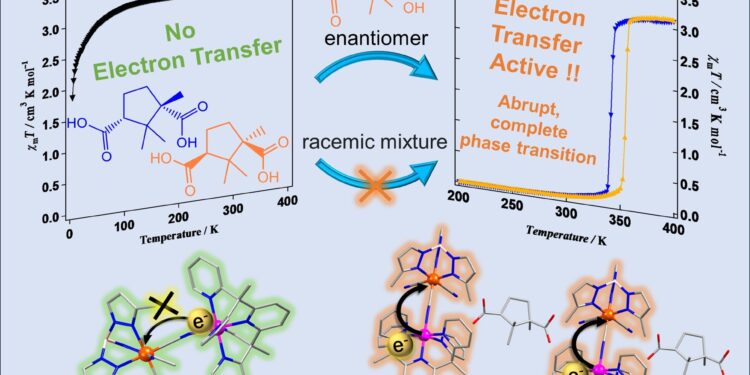By introducing a chiral carboxylic acid as a hydrogen bond donor, the team induced precise magnetic switching behavior in the cobalt-iron molecular assemblies, controlled by temperature changes. Credit: Yoshihiro Sekine, Shinya Hayami, Kumamoto University
A research team from Kumamoto University has successfully developed a new approach to create switchable magnetic materials using hydrogen bonding at the molecular level. Their study shows how certain metal complexes, previously unresponsive to external stimuli, can now exhibit sharp and complete magnetic transitions by introducing chiral hydrogen bonds.
The research team, led by Associate Professor Yoshihiro Sekine of the Priority Organization for Innovation and Excellence (POIE), focused on creating switchable molecular assemblies composed of cobalt ions (Co²⁺ ) and iron (Fe³⁺), which initially generally do not respond to external ions. stimuli. The study is published in the Journal of the American Chemical Society.
The team’s innovation lies in the incorporation of a hydrogen bond via a chiral carboxylic acid, allowing the molecules to switch between magnetic states (paramagnetic and diamagnetic) with remarkable precision. These assemblies, called “molecular analogues of Prussian blue,” show promise for controlled electron transfer between cobalt and iron ions, which was unattainable in conventional materials.
The other key discovery of the study is the role of molecular chirality in the performance of these assemblies. Enantiopure hydrogen bond donor (HBD) molecules allowed sharp and complete magnetic transitions, while racemic mixtures led to disordered structures with broad and incomplete transitions. This highlights the importance of precise molecular arrangement in the development of functional materials with predictable behavior.
“Chiral hydrogen bonding units are crucial for achieving the cooperative and abrupt phase transitions we observed,” said Associate Professor Sekine. “This opens new avenues for designing switchable materials at the molecular level.”
These discoveries could lead to the development of advanced materials for magnetic storage devices, sensors and other electronic applications. The study highlights how subtle changes in molecular structure can lead to dramatic differences in materials behavior, opening a new avenue for the development of functional molecular machines and smart materials.
More information:
Riku Fukushima et al, Assembly of the smallest Prussian blue analogues using a chiral hydrogen bond donor unit towards a full phase transition, Journal of the American Chemical Society (2024). DOI: 10.1021/jacs.4c05065
Provided by Kumamoto University
Quote: A new strategy unlocks magnetic switching with hydrogen bonding at the molecular level (October 18, 2024) retrieved October 19, 2024 from
This document is subject to copyright. Except for fair use for private study or research purposes, no part may be reproduced without written permission. The content is provided for informational purposes only.



